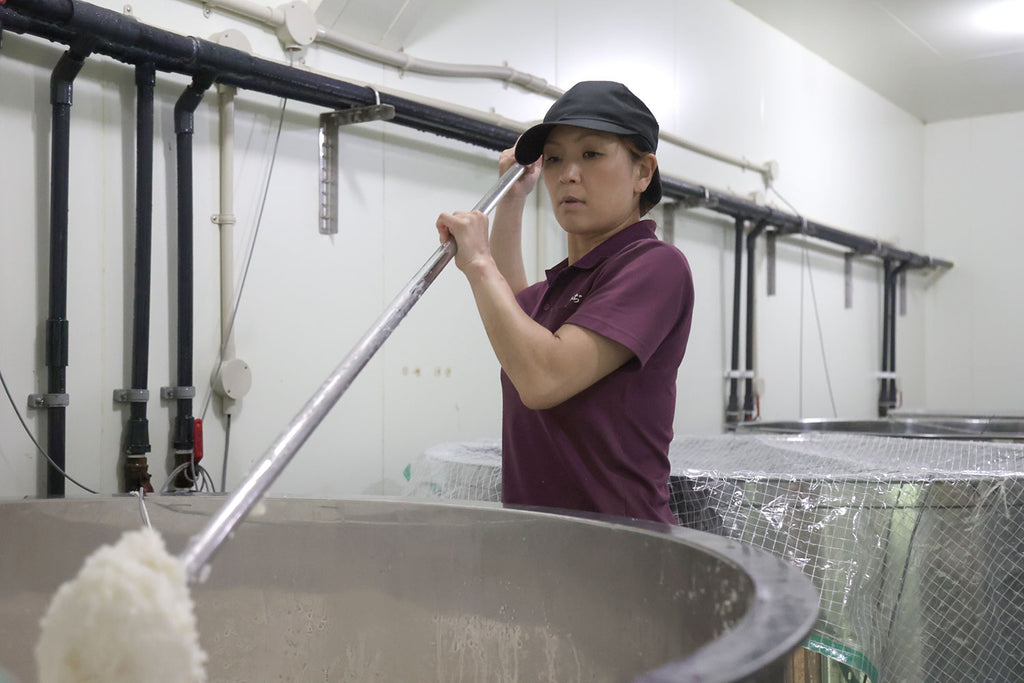Female Frontrunners (March 2024)

Sake Gumi is our monthly sake subscription service with 200 members throughout the country. Join today!
It feels especially meaningful to write about women in the sake brewing industry after just getting back from a weeklong awamori distillery tour in Okinawa, where Kayoko and I were always the only women in the room. It’s the little things you notice when you are the only woman in the room – questions posed are often directed at the other men in the room, and the other women you see are the ones you pass by the reception desk, on the way into the meeting rooms. These cues are mostly subconscious, as we felt very welcome and valued, but there’s no doubt that they snowball into the psyches of young women.
That’s why I am excited to round up another four bottles for Female Frontrunner month. All four are brewed by different women master brewers. Whether they came into the profession as the only family heir willing to take on the business (Mayuko Kita of Kita Shuzo), or they entered the industry through the Employment Security Office (Mie Abe of Hatsumomidi Shuzo), it is clear that the gender barrier in the sake industry has been decreasing in the past decade.
A few brewers have attributed the ability for women to work more methodically and raise children as an advantage when making sake. Abe of Hatsumomidi says, “Sake brewing is like raising children. If you give them love, they will respond. We aim to create sake that can only be done from a female perspective. I believe that this kind of sake brewing is a strength that comes from my experience of raising children.
Additionally, in order to brew sake in a clean environment, we carefully clean everything, applying the skills we know well as women – daily housework.” Matsuura of Honka Matsuura adds, “Many women are methodical and hardworking. This personality can be put to good use in sake brewing, where tidying up and cleaning are important.”
But all the brewers emphasized a bigger picture advantage that people, regardless of race, class, or gender must possess to brew sake. Kita of Kita Shuzo explains, “Sake brewing is a meaningful challenge for both women and men. The important thing is whether you have the desire to face sake brewing wholeheartedly and seriously.” I loved the almost poem-like passage that Matsuura emailed me regarding this subject:
Kanpai,
-Yoko (Sake Director and Co-Founder, Umami Mart)
LEVEL 1

Narutotai Junmai Chokarakuchi Tomoe
Honke Matsuura Shuzo (Tokushima, Japan)
Seimaibuai: Tokushima Yamada Nishiki (koji + kakemai) 70%, SMV: +11, Yeast: LED Dream, Acidity: 1.6
Motoko Matsuura, the master brewer at Honke Matsuura describes this sake as “Not just dry, but super dry!” We get generous aromas of raisin and banana contrasting with a dry, peppery finish that’s great chilled in a wine glass. You can also warm this sake up for a cozy night at home, in a wide mouthed ceramic cup. This was especially delicious with salty bites like chicken liver mousse, or a bowl of roasted nuts. We salute Matsuura who has been making sake for over 40 years. On this subject she says, “The sake I made when I was 20 and the sake I made when I was 40 felt completely different. And as I turn 60 this year, I feel that sake continues to evolve even further.”

Kirakucho Fox Junmai Ginjo
Kita Shuzo (Shiga, Japan)
Seimaibuai: Yamada Nishiki (koji) + Ginfubuki (kakemai) 60%, SMV: +3, Yeast: No. 14, Acidity: 1.8
Foxes are known to be the messengers of the rice-growing god. To give thanks to the foxes that live around the brewery and neighboring Inari Shrine, Mayuko Kita, master brewer at Kita Shuzo developed the idea for this striking bottle. Enjoy aromas of nectarine, and cooked rice with a pleasantly creamy mouthfeel and crisp finish. We love this sake at room temperature or lukewarm. The slightly heightened acidity makes it a great sake to pair with foods that are richer, including yakitori, olives, and canned sardines.

Tenbi Junmai Ginjo
Choshu Sake Brewery (Yamaguchi, Japan)
Seimaibuai: Yamada Nishiki (koji + kakemai) 60%, SMV: N/A, Yeast: No. 901, Acidity: N/A
When asked about the label, master brewer Miki Fujioka explained, “The complex design expresses sake brewing, which is made up of many coincidences and the workings of life, and the craftsman’s commitment to capturing a single moment in order to make great sake.” Enjoy an intense bouquet of green apple and Sweet Tarts. This crisp sake balances citrus-like acidity and a subtle bitterness that lingers in the mouth. Try this sake chilled and have it with roasted poultry, chicken wings or lubya (Afghan beans).

Harada Gengetsu Muroka Genshu Junmai Ginjo
Hatsumomidi (Yamaguchi, Japan)
Seimaibuai: Yamada Nishiki (koji) 50% + Saito No Shizuku (kakemai) 55%, SMV: -1, Yeast: No. 1801 and 901, Acidity: 1.5
Master brewer Mie Abe was approached by Japanese wine importer Mottox to create a sake that was similar to a Bordeaux blend. She decided to use two different rice varietals, “Yamada Nishiki gives power and gravity like Cabernet, and Saito No Shizuku gives freshness like Merlot. Terroir is also important, and Saito no Shizuku is Yamaguchi Prefecture’s representative sake rice, so it represents our terroir.” The result is a sake that boasts a bouquet of melons, french toast, and roses. With subdued acidity it showcases its sweetness, and finished with plenty of umami and round richness on the palette. Abe-san recommends having this sake chilled or at room temperature with cantaloupe melon and proscuitto, as it complements the sake’s aroma.
